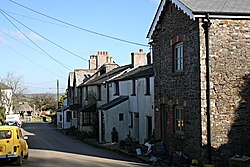Lawhitton
| Lawhitton Cornish: Nansgwydhenn | |
| Cornwall | |
|---|---|
 A terrace of cottages in Lawhitton | |
| Location | |
| Grid reference: | SX355824 |
| Location: | 50°37’1"N, 4°19’34"W |
| Data | |
| Population: | 232 (2011) |
| Post town: | Launceston |
| Postcode: | PL15 |
| Dialling code: | 01566 |
| Local Government | |
| Council: | Cornwall |
| Parliamentary constituency: |
North Cornwall |
Lawhitton is a village in eastern Cornwall, two miles southwest of Launceston and half-a-mile west of Cornwall's border with Devon at the River Tamar.
The parish of Lawhitton is a comparatively small parish and Lawhitton village is the principal settlement. The border with Devon forms the parish's eastern boundary; to the north, it is bounded by St Thomas by Launceston parish; to the west by Launceston parish; and to the south by Lezant parish. The parish population at the 2011 census was 232.
History

In the 880s, the area as within church-owned estates like Polltun, Caellwic, Landwithan (Pawton, in St Breock) and Lawhitton, though eventually they passed to Crown. These estates were granted to the Bishop of Sherborne to whose diocese Cornwall had been added. Landwithan included the parishes of Lawhitton, South Petherwin (with Dunheved, modern Launceston), Trewen and Lezant. In 1050 they passed to the Bishop of Exeter and remained a peculiar deanery of the Bishop until 1850. Consequently, two-thirds of the parish of Lawhitton still belongs to the Church Commissioners. At the time of Domesday Book (1086) the manor was held by the bishop and had 11 hides of land and land for 40 ploughs. The lord had land for 2 ploughs with 7 serfs, and 27 villeins and 20 smallholders had land for 29 ploughs. There was 8 acres of meadow, 100 acres of pasture and 10 acres of underwood. The value of the manor was £17 though it had formerly been worth only £8.[1]
Until 1261 the benefice of Lawhitton consisted of a vicarage and a sinecure rectory; they were then combined as a rectory. From then until 1924 there were 60 rectors, of whom probably only 19 were resident.[2] The last of these rectors was Henry Du Boulay who was concurrently Archdeacon of Bodmin from 1892 to 1924[3][4] Du Boulay was ordained in 1864 and died in 1925;[5] he was the son of an earlier rector of Lawhitton.
Parish church

The parish church of St Michael is of various periods of Gothic architecture. The plan is unusual and the tower stands in the position of a south transept. The tower is 13th century in date and there is a north aisle.
The font is Norman, of the Altarnun type. Features of interest include the Jacobean pulpit, 1665, and two monuments, to R. Bennet (d. 1683) and in Coade stone to Richard Coffin (d. 1796).[6]
| ("Wikimedia Commons" has material about Lawhitton) |
References
- ↑ Thorn, C. et al., ed. (1979) Cornwall. Chichester: Phillimore; entry 2,9
- ↑ Cornish Church Guide (1925) Truro: Blackford; pp. 139-40
- ↑ Prussia Cove houses ("Cornwall" is a mistake here)
- ↑ "Cornwall Record Office; du Boulay". Cornwall Council. http://crocat.cornwall.gov.uk/DServe/dserve.exe?dsqIni=Dserve.ini&dsqApp=Archive&dsqCmd=Overview.tcl&dsqSearch=(Title='du')&dsqDb=Catalog&dsqPos=0. Retrieved 24 September 2011.
- ↑ Brown, H. M. (1976) A Century for Cornwall. Truro: Blackford; p. 89
- ↑ Nikolaus Pevsner: The Buildings of England: Cornwall, 1951; 1970 Penguin Books ISBN 978-0-300-09589-0
